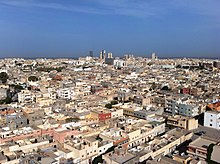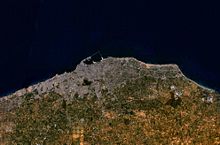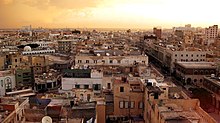Tripoli
This is the sighted version that was marked on March 21, 2021. There is 1 pending change that needs to be sighted.
![]()
This article is about the Libyan capital. For other meanings, see Tripoli (disambiguation).
Tripoli (Arabic طرابلس, DMG Ṭarābulus, tamazight ⵟⵔⴰⴱⵍⵙ Ṭrabls, Greek Τρίπολης 'three cities', Latin Oea, Italian Tripoli) is the capital of Libya.
Tripoli is the political, economic, and cultural center as well as the transportation hub of the country. To distinguish it from the Lebanese city of Tripoli, which has the same name in Arabic, Tripoli is often called Tarabulus al-gharbiyya / طرابلس الغربية / 'Western Tarabulus'.

Tripoli skyline
Geography
The city is located in the northwest of the country on the Mediterranean Sea, an average of 84 meters above sea level. The urban area of about 250 square kilometers stretches about 40 km along the coast with a development depth of three to ten kilometers.
Climate
Tripoli is located in the subtropical climate zone. The average annual temperature is 20.5 degrees Celsius, the average annual rainfall is 334 millimeters.
The warmest month is August with an average of 27.7 degrees Celsius, the coldest is January with 13.4 degrees Celsius.
The most precipitation falls in the month of December with 67.5 millimeters on average. Between June and August there is almost no precipitation.
| Tripoli | ||||||||||||||||||||||||||||||||||||||||||||||||
| Climate diagram | ||||||||||||||||||||||||||||||||||||||||||||||||
| ||||||||||||||||||||||||||||||||||||||||||||||||
| Monthly average temperatures and precipitation for Tripoli
Source: wetterkontor.de | ||||||||||||||||||||||||||||||||||||||||||||||||||||||||||||||||||||||||||||||||||||||||||||||||||||||||||||||||||||||||||||||||||||||||||||||||||||||||||||||||||||||||||||||||||||||||||||||||||||||||||||||||||||||||||||||||||||||||||||||||||||||||||||
History
Ancient
The city of Tripoli was founded in the 7th century BC by the Phoenicians under the name of Oea. Among the Sicilian Greeks, the region of the three cities of Oea, Sabratha and Leptis Magna was called Tripole (Greek Τρίπολης 'three cities'). Later the name of the region passed to the largest of these three cities. Tripoli formed an intermediate territory of Carthage in antiquity, the so-called Regio Syrtica.
After the Second Punic War, the Romans ceded it to Numidia, and after its subjugation it was added to the Roman province of Africa. Under Septimius Severus, the Provincia Tripolitana was formed in the 3rd century AD with Oea as its capital, to which the name Tripolis then passed. The economic heyday ended with the decline of the Roman Empire.
After invasions by nomadic peoples and the Vandals, the population dropped from about 30,000 to 7,000.
Medieval
After the Arab invasion in the 7th century, Tripoli shared the fortunes of Barbary. In 1146 the Normans conquered Tripoli and installed there the family of Ibn Matruh as vassals. The latter rebelled in 1158 and submitted to the rule of the Almohads in 1160. In 1228, the city placed itself under the rule of the Hafsids. Almohad and Hafsid control over Tripoli was mostly nominal. The city often remained at the mercy of threats from surrounding tribes and European invaders. In 1324, the Banu Thabit gained control of Tripoli. In 1354, the Genoese Filippo Doria sacked the city with a fleet and sold it to Ahmad bin Makki, who placed himself under Merinid suzerainty. The Banu Thabit were able to regain control in 1370. In 1401 Tripoli came back under the rule of the Hafsids. In 1460, a local sheikh named Mansur rebelled against the Hafsids. He and his descendants ruled Tripoli until 1510, when it was conquered by the Spanish Count Pietro of Navarre and a Spanish governor was installed. Emperor Charles V gave it to the Knights of St John as a fief in 1530, but by 1551 it was conquered by Ottomans under Turgut Reis (Dragut), who was then appointed Bey of Tripoli by the Sultan. Tripoli became a province of the Ottoman Empire, ruled by a governor who bore the local title of bey. The had an administration of local Ottoman officials and a corps of Janissaries recruited in Anatolia. Qādī was a Hanafite, although most of the inhabitants were Mālikites. In the early 17th century the local janissaries seized power, and their elected spokesman, the dey, shared it with the governor. Tripoli could not maintain an army because of lack of resources; it had little agricultural land, and its few towns were small. It did, however, maintain a navy, which was used for privateering operations against the merchant shipping of European states. The military commanders of the "Pirates of the Barbary Coast" formed their own dynasties in Tripoli as well as in the Ottoman province of Tunis, but were not independent monarchs; they continued to be appointed by the Ottoman sultan.
Modern Times
In 1711, the Turkish pasha Ahmad Qaramanli (the Great) made himself almost independent of the Porte by paying tribute only, and founded the Qaramanli dynasty (1711-1835). The French campaign against Tripoli, undertaken in 1728, ended in the almost complete destruction of the city. In 1801, the American-Tripolitan War broke out because of piracy. Only the French conquest of Algiers (1830) put an end to the piracy that also originated in Tripoli.
In 1835, the Porte was prompted to intervene by the internal disruption prevailing in Tripoli and put an end to the rule of the Karamanli family, whereupon Tripoli was incorporated into the Ottoman Empire as Eyâlet (1866 Vilâyet).
Modern
Tripoli was occupied by Italy during the Italian-Turkish War in 1911 and ceded to Italy under international law in 1912. Under the Italian colonial regime, there were massive attempts at Italianization through forced immigration; at times, the city had about one-third Italian population.
During World War II, British troops occupied the city on 23 January 1943. In 1945, the anti-Semitically motivated Pogrom of Tripoli took place against the city's Jewish minority, killing about 140 Jews. Another bloody pogrom took place in 1948. After Libya's independence (1951) under King Idris and the formation of a unitary state, Tripoli became the country's capital in 1963. The economically dominant role of the Italian minority initially remained largely unaffected by these political changes. It was only after the Libyan revolutionary regime took power in the summer of 1969 that an exodus of the Italian population began in 1970. Symbolic structural changes, such as the conversion of Tripoli's cathedral into a mosque, reflected these political changes.
In 1986, the city was the target of U.S. airstrikes ordered by the U.S. government in retaliation for Libya's alleged support of terrorist activities (Operation El Dorado Canyon).
Civil war 2011
During the Libyan civil war, the city was firmly in the grip of the Gaddafi government, which also had its headquarters there, until it was captured by Libyan rebels in August 2011. Demonstrations like those in the eastern part of the country were quickly dispersed. In the course of the international military campaign, Tripoli was therefore subjected to repeated NATO bombing raids.
Tripoli was dominated by militias after the end of the civil war. Named were mostly:
- the Tripoli Revolutionary Council under Abdullah Naker (also Abdullah al-Zintani), attributed to the Sintan Brigades. His units controlled Tripoli International Airport until it was handed over to the government in April 2012. Nakar has announced that he will form a political party.
- the units of the Tripoli Military Council under Abd al-Hakim Balhadsch, the former leader of the Libyan Islamic Fighting Group. Balhadsch is said to have financial support from the Emirate of Qatar.
- the units of the Misrata military council
- the Libyan Army units, initially led by Chief of Staff Khalifa Haftar. On January 3, Haftar was replaced by Yousef al-Manqoush. Haftar had pushed for the disarmament of the militias, but is said to have been too interested in his own power in the process. Al-Manqoush has good connections to Defense Minister Usama al-Juwaili, who heads the Sintan Military Committee, which in turn is linked to the Tripoli Revolutionary Council.
Civil war since 2014
After the outbreak of the new civil war in Libya, the city was captured by the counter-government militias in September. Since then, it has served as the seat of the counter-government and the old parliament it reinstated. In the summer and fall of 2014, the city was the target of airstrikes by General Haftar's forces, Egypt's forces, and the forces of the United Arab Emirates. In the course of the UN-led peace process, the airstrikes on Tripoli by the internationally recognised government were initially suspended.
Population development
The following overview shows the population figures according to the respective territorial status. The rapid development of the population since 1970 is partly due to incorporations.
|
|

Satellite image of Tripoli

Old town of Tripoli
Search within the encyclopedia